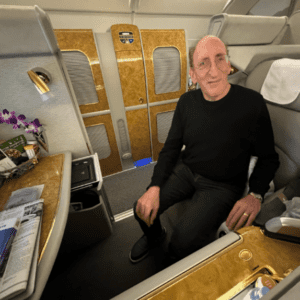 It is human nature to always look for a better, more enhanced experience. Arguably, innovation is the key idea that is shaping corporate life, or even defining the actual corporate mission. Hospitality firms are not indifferent to the changes occurring at the level of their competitors, the fast-paced market, or emerging technology breakthroughs.
It is human nature to always look for a better, more enhanced experience. Arguably, innovation is the key idea that is shaping corporate life, or even defining the actual corporate mission. Hospitality firms are not indifferent to the changes occurring at the level of their competitors, the fast-paced market, or emerging technology breakthroughs.
Yet, as we have argued before in previous articles, the bulk of the hotel industry is somehow lagging behind. There is however a leading group of firms that not only keep up with the pace of innovation but are able to innovate the very way they provide customers with enhanced experiences.
How do top hoteliers think, tinker with and discover a more innovative, personalized and memorable customer experience? We have analyzed several disruptively innovative approaches from leading hotels.
Open versus closed innovation
The one word answer to the question above is opening the innovation process to users and customers. The idea of using contests to stimulate innovation has a long history. Back in 1795, Napoleon offered an award of 12,000 francs to improve upon the prevailing food preservation methods. AfterÊ14 years of experimentation, Nicolas Appert claimed the prize when he devised the same basic technology that is still used to can food today.
And yet, generating ideas for new services used to be the exclusive domain of top management, marketers, and/or designers. Not anymore. Many industries have been relying on open innovation as a source of strategic innovation to continue growing and to continue catering to ever-changing customer demand. Open innovation activities (co-design, co-creation, crowdsourcing and contests) are powerful instruments to stimulate innovations in diverse fields of application. These collaborative innovations engage a variety of external stakeholders, including users, designers, producers (management and coworkers) and suppliers.
Employees are extremely knowledgeable about their business and their integration into the early phases of an innovation process brings in creativity while mitigating the not-invented here syndrome. Nevertheless, the average hospitality incumbent does not have proper training on the newest gadget/technology available. To be completely blatant, they do not know of certain existing technologies or how an application actually works. Using the same judgement, an IT person cannot understand the core of hospitality. What if they would be brought together and placed in a friendly, potentially unconventional, environment that fosters creativity, such as the suite of a hotel or a section of an art gallery/museum? Telling people to think outside the box won’t actually make them do so, showing them how to think outside the box might.
Best practices in open innovation
Among hotels, some first movers have already started experimenting with crowdsourcing and open innovation. In this article, we document two of them. These innovation contests refer to the early stages of the innovation process.
The Lopesan Group in Spain organizes a contest where employees come up with creative ideas, suppliers and companies from related service industries discuss the scope of the initiatives, students with different backgrounds help develop them, and top management evaluates the solutions. Every year since 2012, Lopesan Group has produced the ÔThink in Innovation’ Contest, bringing together colleagues from other companies, students from around the world, employees eager for innovative experiences and management deeply convinced of the value of service innovation. From IT apps to workplace design, from management practices to new service offering to operational solutions, each initiative takes advantage of an intensive twoday sort of hackathon initiative to bring ideas out into the real world. Each year, Thinking in Innovation generates a set of ideas, and each year, hundreds of participants gather in the Gran Canaria’s Exhibition and Convention Center for a full weekend of fun and work.
Take also the example of Park Inn by Radisson Manchester City Centre. Their management team arranges an open innovation contest where teams from several hotel management schools take part in a three-day kick-off event in Manchester. Students attend a set of conferences, exchange ideas with peers and, afterwards, develop innovative ideas that will help revolutionize the Park Inn by Radisson guest experience. These ideas are further submitted for consideration by the contest judges and the public votes. Driven by an open innovation spirit, a dedicated webpage allows the public to choose their favorite innovation. Two innovations move to the final stage of the contest where the judges select the final winner. Blending a mix of cutting-edge conference content with innovative experiences from leading creative teams, ParkInn Innovation is the one essential innovation event for Park Inn by Radisson Manchester City Centre seeking to harness the power of creativity and the dynamic interplay that is underway. All these ideas have as a purpose to foster change starting from the heart of the business: including customers, students and hotel employees. The belief that the employee interacts with the guest every day or that the hotel management student knows what the Ònew customerÓ wants is valid, but does not suffice. Innovation contests have the ability to create the conditions for innovation to thrive.
Co-creation involves a bigger picture
Just to clarify, these innovation initiatives are not driven by branding or marketing models. Surely, marketing strategies attempt to create memorable experiences, become trendsetters and enable a unique brand journey. Instead, the examples offered here are strategy-centered innovations driven by organizational needs for service, business model and process innovations.
A quote often attributed to Albert Einstein states that insanity is to keep doing the same thing over and over again and to expect different results. Customers are now used to receiving a service that is adapted and customized to their own specific needs. The industry has caught on to the trend and is scrambling to innovate every aspect of its business. Today’s hoteliers understand that innovation thrives on technology, new apps, social media, new services and service processes, as well as new management and organizational tools and techniques.
ÒService is a monologue, hospitality is a dialogueÓ Danny Meyer coined this phrase in his bestselling book, Setting the Table. Open innovation helps open up the dialogue. Hoteliers can unlock their innovation strategy by combining the key elements mentioned above: the perspective of the up-and-coming millennial student, the work and experience of the current employee, the educated view of the guest, and management’s profound technological awareness.
By Carlos Martin-Rios and Sabina Savatin Ê
About the authors
Dr. Carlos Martin-Rios (PhD Rutgers University) is Assistant Professor of Organizational Innovation and HRM at the cole htelire de Lausanne. He performs research that aims to understand and predict the factors that determine nontechnological innovation (e.g., business model innovation, organizational innovation, and management innovation), interfirm collaborations and knowledge exchanges, and innovative talent management in knowledge-intensive service firms at large and, in particular, hospitality firms.
Sabina Savatin is a final year student at the cole Htelire de Lausanne (EHL), pursuing a bachelor of science in international hospitality management. EHL is renowned as the leading hospitality school, preparing its students for an ever-changing industry. Sabina participated in the ÒThinking in InnovationÓ contest, organized by the Lopesan Group.



















